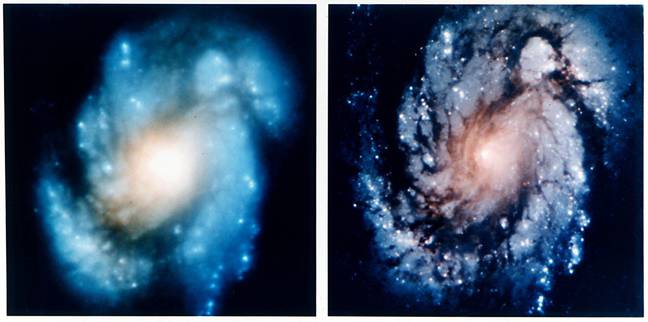Pics On 24 April, 1990, the space shuttle Discovery lifted off from Kennedy Space Centre in Florida carrying a very special cargo: 24,490lbs (11,110kg) of advanced optics, electronics, and antennas that made up the Hubble Space Telescope.
The telescope has revolutionised our understanding of the universe, in part thanks to five servicing missions that added new capabilities. The skills and technologies developed in the process are now being used to build other, better 'scopes, both on Earth and outside our gravity as well.
But as we celebrate the Hubble's anniversary, it's worth remembering that it nearly didn't get off the ground, and that when it did, its first three years of results were hardly stellar – some pun intended.
The ambitious plans for Hubble, which would be the most technically advanced telescope of its time, started in the 1970s. Almost immediately it ran into problems. The U.S. Congress cut funds, then reinstated them, then nearly killed the entire project altogether.
Once the basic telescope was complete, it was scheduled for launch in October 1986, but in January of that year the shuttle Challenger blew up shortly after takeoff and the rest of the fleet was grounded. It was a disaster for NASA, and very expensive for the Hubble team.
Because the telescope was already assembled, it had to be stored very carefully in a clean room flushed out with nitrogen, at a cost of around $6m per month. It was more than three years before Hubble could finally be packaged up and loaded onto a space shuttle, although the delay did allow the team to upgrade certain instruments with better technology.
Once Hubble was in orbit the control team quickly discovered that something was seriously wrong. Hubble was sending back images that were blurry at best, and its key mission goals could not be carried out. There was consternation when it was discovered that the main mirror had been incorrectly ground.
"The mirror was a wavelength of light too shallow because the camera tracking the polisher was very slightly out of position," Dr Patrick McCarthy, director of the organization that is building the Giant Magellan Telescope and Hubble team member told The Register.
"On the ground we could have either repolished the mirror or bent the mirror by a tiny amount to fix the problem. But Hubble can't bend its mirror because we didn’t think that was needed. Instead we inserted another device to cancel out the aberration."

Before and after the Hubble flaw fix
The fix was performed in December 1993 when a team of astronauts, who had undergone training in the nearly 100 specialised tools needed to service the telescope, removed one of the scientific instruments and installed the corrective device, dubbed the Corrective Optics Space Telescope Axial Replacement.
It was the first of five servicing missions that upgraded and repaired the telescope through 2009. With the retirement of the shuttle fleet no further repair missions are possible – and the last one, which installed the Wide Field Camera 3 (WFC3), nearly didn’t happen.
The 2003 disaster that destroyed the space shuttle Columbia on re-entry threw the Hubble schedule into disarray. NASA cancelled the final servicing mission on safety grounds, and it was determined that all future shuttle missions must be able to dock with the International Space Station if necessary, for safety purposes. The shuttle didn't carry enough fuel to do that and service Hubble on the same run.
"We had an Irish wake for Hubble after the final servicing mission was cancelled," Dr McCarthy recalled. "It was a blow, but then NASA changed its mind and the mission was put back on schedule."
The final servicing mission also allowed the astronauts to replace key components, including batteries and a new data handling module. Hubble had been reduced to running in backup mode after its first data unit failed weeks before the servicing mission was due to fly.
Hubble will remain in orbit, around 350 miles up, for the foreseeable future and – barring equipment failure – should be able to continue its scientific mission for decades to come. But its low orbit means the telescope will eventually come back to Earth and, based on currently available technology, there's no way to bring it back safely in a vehicle.
Left unattended, the telescope would be expected to fall back to Earth in around 2040 or 2045. But this can't be allowed to happen – parts of the massive instrument will survive the trip back through Earth's atmosphere and could fall on populated areas.
"NASA has a plan to send up a de-orbiting module that attaches to Hubble and drives it into orbital decay mode to allow it to be brought down into the ocean or on unpopulated land," Dr McCarthy explained. "After all, you wouldn't want someone to be killed by Hubble. But the orbital decay time is so far into the future there may be other options. But whatever happens they have a plan and an engineering solution."
Space boffins have now turned their attention to the next big orbital instrument, the James Webb Space Telescope. This huge device will be parked 1.5 million kilometres from Earth – so no servicing missions will be possible – but the lessons of Hubble have been crucial to getting the instrument built.
The same is true here on Earth.
The designers of the Giant Magellan Telescope, which will be built in Chile, have also learned from Hubble and the results are going to be spectacular. When completed, this ground-based telescope will have ten times the resolution of Hubble and will be able to look back to a few hundred million years after the Big Bang. ®
Sponsored: Benefits from the lessons learned in HPC
from ffffff http://go.theregister.com/feed/www.theregister.co.uk/2015/04/25/hubble_celebrates_25_years_in_space/
via IFTTT







0 comentarios:
Publicar un comentario